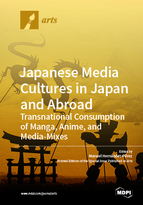Japanese Media Cultures in Japan and Abroad: Transnational Consumption of Manga, Anime, and Media-Mixes
A special issue of Arts (ISSN 2076-0752). This special issue belongs to the section "Film and New Media".
Deadline for manuscript submissions: closed (30 April 2018) | Viewed by 123400
Special Issue Editor
Interests: media and psychology; narrative theory; transmedia; cross-cultural readings; narrative video games
Special Issue Information
Dear Colleagues,
In the last few decades, Japanese popular culture productions have been consolidated as one of the most influential and profitable global industries. As a creative industry, Japanese Media-Mixes generate multimillion-dollar revenues, being a product of international synergies and the natural appeal of its characters and stories. The transnationalization of investment capital, the diversification of themes and (sub)genres, the underlying threat to the proliferation of illegal audiences, the development of internet streaming technologies and other new transformations in media-mix based production models, make the study of these products even more relevant today. In this way, manga (Japanese comics), anime (Japanese animation) and video games are not necessarily products designed for the national market. More than ever, it is necessary to reconcile national and transnational positions for the study of this cultural production.
We would like to invite potential contributors, either professionals or scholars, to submit their contributions to be considered by our review panel for a Special Issue of Arts. These discussions will be aligned to the analysis of Japanese Popular Cultural flows from any perspective (Cultural Studies, Film and/or Comic studies, Sociology, etc.) with special emphasis on manga, anime and video games. Some of the questions that can be addressed in this Special Issue, including, but not limited to:
- Studies on audiences: national and transnational case studies;
- Fandom production and otaku culture;
- Relationship of Japanese popular culture and Japanese society;
- Anime and authorship: main figures;
- Cross-media and transmedia perspectives.
Guest Editor
Manuscript Submission Information
Manuscripts should be submitted online at www.mdpi.com by registering and logging in to this website. Once you are registered, click here to go to the submission form. Manuscripts can be submitted until the deadline. All submissions that pass pre-check are peer-reviewed. Accepted papers will be published continuously in the journal (as soon as accepted) and will be listed together on the special issue website. Research articles, review articles as well as short communications are invited. For planned papers, a title and short abstract (about 100 words) can be sent to the Editorial Office for announcement on this website.
Submitted manuscripts should not have been published previously, nor be under consideration for publication elsewhere (except conference proceedings papers). All manuscripts are thoroughly refereed through a double-blind peer-review process. A guide for authors and other relevant information for submission of manuscripts is available on the Instructions for Authors page. Arts is an international peer-reviewed open access semimonthly journal published by MDPI.
Please visit the Instructions for Authors page before submitting a manuscript. The Article Processing Charge (APC) for publication in this open access journal is 1400 CHF (Swiss Francs). Submitted papers should be well formatted and use good English. Authors may use MDPI's English editing service prior to publication or during author revisions.
Keywords
- Japan
- popular culture
- anime
- video games
- manga





